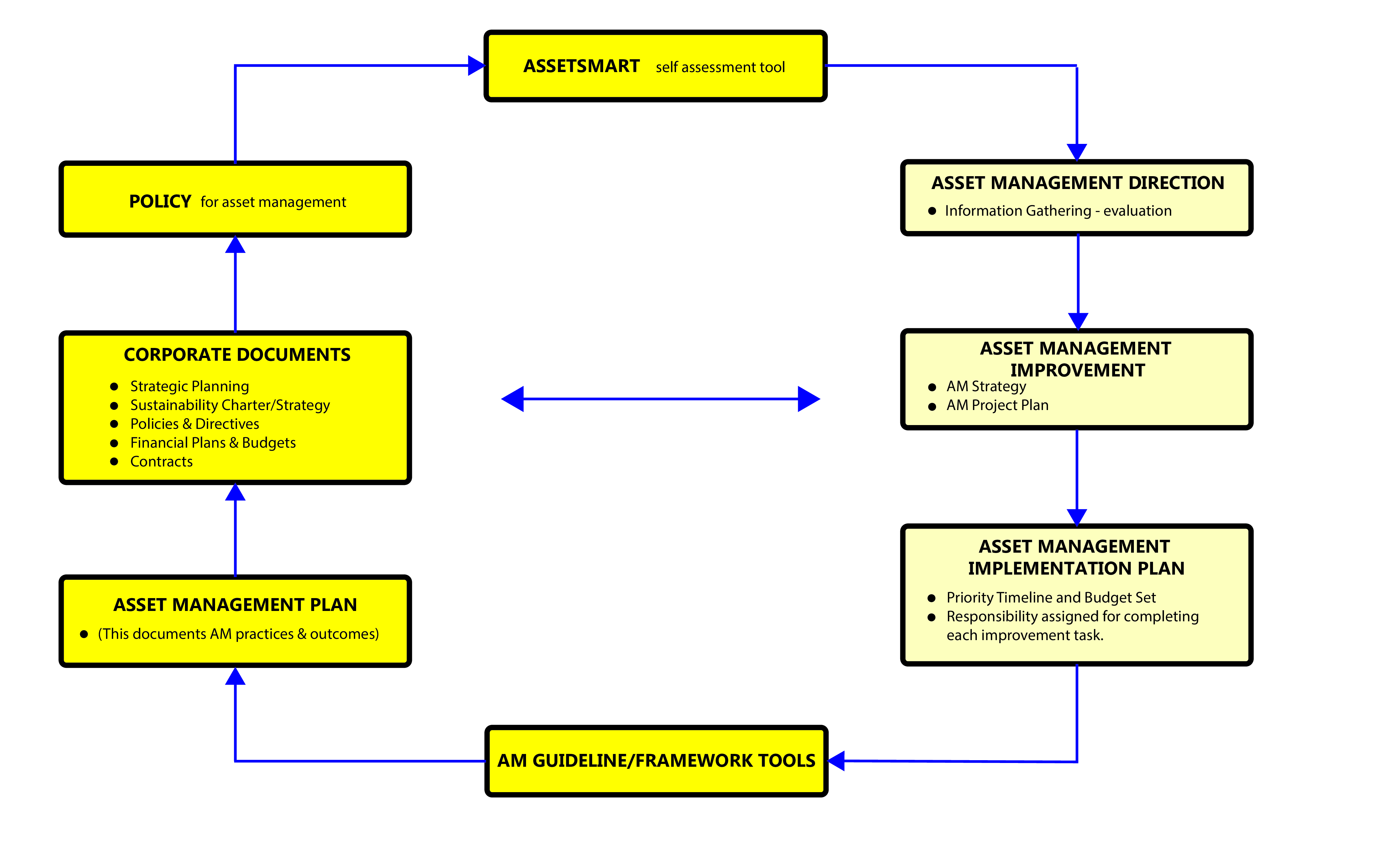8.1: What is Asset Management (AM)?

Asset management is a coordinated activity of an organization to realize value from assets. The activity can also refer to the application of the elements of the asset management system, the approach, the planning, the plans, and their implementation. (ISO 55000: 2014 standard)
Asset management (AM), as practised today, is a fundamentally new way of thinking about physical assets and how to use them to create value for the organization. Because AM is such a vast topic, it should come as no surprise that a number of AM strategies have been formed based on unique organizational practices or distinct personal understanding of individual specialists. However, we can say that AM is a strategic approach to maximizing the value of an organization’s assets. Therefore, it represents one of the organization’s critical, comprehensive, and proactive competitive advantage philosophies.
AM is a set of ideas that can help a company improve how it does business and makes decisions. It also helps a company improve the ways in which it processes, uses, and communicates data related to its infrastructure management. AM is largely concerned with how an organization allocates and uses resources, including money, people, skills, and information. It offers a consistent, integrated framework for planning, program formulation, and program delivery across the organization’s various assets. Therefore, it is becoming a critical component of project management.
AM encourages the use of several quality standards within an organization’s processes, such as evaluating all options at each stage of a decision-making process, conducting project economic analysis from a long-term perspective, assessing trade-offs across initiatives, monitoring program effectiveness and system performance, and leveraging management and information systems throughout the AM cycle. All of these are critical aspects of the project management life cycle. AM is steered by policy objectives and goals. As such, it is goal-oriented, with explicit performance and accountability metrics.
It can also be stated that AM refers to the management of tangible and intangible project properties, which are typically the processes of managing and rearranging the project deliverables (i.e., outcomes). AM encompasses the classic project management area of version control, but in more recent times, it has also begun to cover new areas of project property control. Furthermore, in times of disruption and ongoing digital transformation, we would say that the AM process should encompass the whole project life cycle, beginning with design and procurement and continuing through operation and maintenance before finally being retired, resulting in even more project value.
Asset Management Strategy
Actions within the AM system and other organizational activities influence organizational strategy creation and implementation. Developing an asset management strategy is an ongoing activity dependent on the interplay between corporate or company plans and the actions of the organization in which they are implemented. To achieve sustained competitive advantage, strategy formulation should be viewed as an organizational capacity that can be cultivated at many levels within the organizational structure (Gordon, 1998). AM is thought to be a component of the organizational strategic management system and to play a role in the creation and execution of organizational strategies. As a result, any architecture for the asset management system should identify the system’s role in creating and implementing a strategy.
The process of value creation is related to the performance of an asset. The performance output is determined in the production or operation process and depends on the capability of the asset throughout the project utilization phase. The capability and performance of assets during the utilization phase depend on the design procedures in the design phase. So, the effective execution of asset-related activities throughout the various life cycle stages of an asset is critical to a project’s success.
Applied to any organization, AM is a strategic business model that demonstrates good asset ownership, effective asset management and service management, responsible stewardship, and long-term sustainability progress. However, there is a misconception that AM merely aims to collect and integrate current management systems and data. AM is, therefore, perceived to be a continuous process. However, it goes much further than that. The strategic value of AM lies in its ability to build on existing procedures and tools, as well as complement and expand current practice, all via a process of continual evaluation and development. This process results in the creation of an AM blueprint, which acts as a roadmap for improving business and service delivery under the supervision of a project manager.
Organizations employ specialized frameworks and guidelines for their assets, which are typically taken from the asset manufacturers’ recommendations. Still, their overall management system is typically established experimentally via their own practice. As a result, there are various viewpoints on what “Total Asset Management Strategy” implies to each organization’s structure. Therefore, we can state that the strategy is shaped around the complexity, design, and specific assets engaged in the organization.
For AM to contribute to an organization’s success, important activities, connections, and procedures must be identified, formed, and managed inside the business. In other words, an AM strategy must be investigated, with fundamental AM procedures and enablers established as part of a comprehensive approach to achieving the organization’s strategic goals (Clash & Delaney, 2000).
Projects are responsible for creating the assets that will be managed and for the enhancement and some upkeep of such assets. Therefore, the management of assets and the management of projects are intertwined in many ways. It is, therefore, important that the project manager is involved in AM frameworks as early as possible to get familiar with all the required actions within AM.
Organizational departments have traditionally been responsible for actions connected to assets or life cycle processes, such as asset design, asset operation, and asset maintenance. Other asset management activities, such as measurement and analysis, planning, development, modification, and any investment work, are always carried out by relevant departments for the unique purposes of each department. Yet, the project manager should be a key stakeholder in these actions. Budgets are always stated, resources are always allocated, and information regarding the health and performance of assets is always collected in some form or another. Numerous departments within the business carry out these operations; however, they may not be integrated and maximized to achieve the firm’s strategic objectives. It is here that project managers undertake an important task: integration.
To achieve the organizational strategy, the objective of this new discipline, known as AM, is to generate collaborative activities inside the organization’s system, which are then carried out by the organization’s employees and subsequently support the organization’s strategy. However, if this is misguided, the strategic support to the organization can be jeopardized.
Researchers have produced an array of management system types relating to physical assets over the course of history. This range includes maintenance management, strategic AM, engineering AM, property AM, infrastructure AM, enterprise AM, and other commonly used words. As a result, AM is important to all sorts of industries and the assets engaged in those industries. Accordingly, AM systems should be tailored to the alignment, culture and commercial objectives of the individual company or sector in which they are used.
In the early phases of establishing an AM approach, there are typically many unknowns and assumptions that must be made to proceed. As a result, it is necessary to begin with a straightforward holistic (i.e., broad) strategy to generate early momentum and establish the foundations of understanding, information, and procedures in the organization. This initial effort may then be modified by the project manager and the project management team, adapted, and expanded in terms of depth of information and complexity with the use of reference texts, as well as other sources. Exhibit 8.1 shows a holistic approach to AM strategy. Each process highlighted in Exhibit 8.1 identifies an asset management practice to be implemented. Some of these practices will be discussed in a later module.

Factors Influencing Inventory Management in the Public Sector
Inventory consists of goods owned and held for customer satisfaction. Inventory is necessary for any organization, although various costs accrue as a result of keeping too much inventory. Therefore, it is important for any organization to keep a good balance between the amount of inventory to keep at any one time to ensure that internal and external customers are satisfied without causing the organization to incur high inventory costs.
Both the public and private sectors must embrace good inventory management practices as a tool for enhancing the performance of the procurement process. For effective inventory management to be achieved, the government should put more emphasis on enforcing the procedures for conducting regular audits.
E-procurement in the public sector also increases transparency in procurement through the electronic publishing of tender notices and contract awards, enhancing accountability and reducing instances of corruption in inventory management.
Checkpoint 8.1
Image Description
Exhibit 8.1: The diagram displays a structured approach to asset management, outlined through a series of interconnected yellow rectangular boxes with black text and borders against a white background. Arrows denote the flow of processes and information. The process starts with “ASSETSMART (self-assessment tool)” at the top, leading right to “ASSET MANAGEMENT DIRECTION,” which notes “Information Gathering – evaluation.” This directs downward to “ASSET MANAGEMENT IMPROVEMENT,” detailing “AM Strategy” and “AM Project Plan.” Below it is “ASSET MANAGEMENT IMPLEMENTATION PLAN” stating “Priority Timeline and Budget Set” and “Responsibility assigned for completing each improvement task.” On the left, “AM GUIDELINE/FRAMEWORK TOOLS” connects to the “ASSET MANAGEMENT PLAN” mentioning “(This documents AM practices and outcomes),” which flows further to “CORPORATE DOCUMENTS” containing “Strategic Planning,” “Sustainability Charter/Strategy,” “Policies and Directives,” “Financial Plans and Budgets,” and “Contracts.” Heading upwards, this connects to “POLICY for asset management.” Blue arrows indicate the process flow between these elements.
[back]
Attributions
“8.1 Asset Management” is remixed and adapted from the following sources:
“Module 1. Definitions and Importance of Asset Management and Project Governance” in A Manual for Project Governance and Asset Management, copyright © 2022 by Carmen Reaiche and Samantha Papavasiliou, licensed under a Creative Commons Attribution 4.0 International License, except where otherwise noted.
“Factors Influencing Inventory Management in Public Sector: A Case Study of Kajiado County Hospital” (2017) by Nurwin Fozia Rajab, Saad Okwiri, Oruru Sebastian & Faraj Yatundu in Kabarak Journal of Research and Innovation, licensed under a Creative Commons Attribution 4.0 International License, except where otherwise noted.
Exhibit 8.1 is adapted from Figure 1: AM Strategy from “Module 1. Definitions and Importance of Asset Management and Project Governance” in A Manual for Project Governance and Asset Management, copyright © 2022 by Carmen Reaiche and Samantha Papavasiliou, licensed under a Creative Commons Attribution 4.0 International License, except where otherwise noted. This rendition copyright © 2024 Conestoga College, CC BY-NC-SA 4.0.
The multiple choice questions in the Checkpoint boxes were created using the output from the Arizona State University Question Generator tool and are shared under the Creative Commons – CC0 1.0 Universal License.
Image descriptions and alt text for the exhibits were created using the Arizona State University Image Accessibility Creator and are shared under the Creative Commons – CC0 1.0 Universal License.
A coordinated activity by an organization to realize value from assets.
The phases involved in the management of an asset. These vary across industries.
A strategic plan for the management of an organization’s assets that will be utilized to fulfil the organization’s or corporation’s objectives.
An object, or entity that has potential or actual value to a company.

